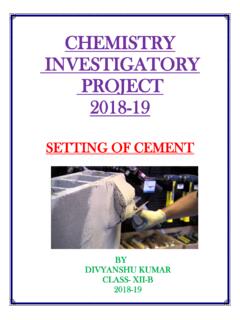Transcription of Chemistry Investigatory Project - Weebly
1 Chemistry Investigatory Project By . Dhananjay Dhiman 2016-17. XII A. CBSE Examination Roll No. - Shivarampally 1. Certificate This is to certify that this Chemistry Investigatory Project has been successfully completed by Dhananjay Dhiman of class XII A under the guidance of Mr. B. Venkaiah in particular fulfilment of the curriculum of Central Board of Secondary Education {CBSE} leading to the award of annual examination of the year 2016-17. Teacher In-Charge External Examiner 2. Acknowledgements I have taken efforts in this Project . However, it would not have been possible without the kind support and help of many individuals. I would like to thank my principal Dr. NSK Swamy and school for providing me with facilities required to do my Project . I am highly indebted to my Chemistry teacher, Mr.
2 B. Venkaiah, for his invaluable guidance which has sustained my efforts in all the stages of this Project work. I would also like to thank my parents for their continuous support and encouragement. My thanks and appreciations also go to my fellow classmates and the laboratory assistant in developing the Project and to the people who have willingly helped me out with their abilities. 3. INDEX. Contents Page No. 1. Objective 5. 2. Introduction to Green 6. Chemistry 3. Principles of Green 7. Chemistry 4. Bio Diesel: Using 11. renewable resources 5. Activity 1 Making 14. Bio Diesel 6. Activity 2 Testing 17. Bio Diesel 7. Activity 3 Potential 20. for Bio fuels 8. Bio Petrol 30. 9. Conclusion 33. 10. Bibliography 34. 11. End of Project 35. 4. Objective The objective of this Project is to study Green Chemistry Bio Diesel & Bio Petrol and also to study Extraction process of Bio Diesel.
3 5. One of the most Introduction to important new aspects of Chemistry is green Chemistry the development of GREEN. Chemistry . supported by the American Chemical Society, the USEPA. and other federal agencies. GREEN. Chemistry has emerged as an important aspect of all Chemistry . GREEN. Chemistry is the design of chemical products and processes that reduce or eliminate the use and generation of hazardous substances. GREEN. Chemistry is based on twelve principles. 6. Green Chemistry is the branch of Chemistry concerned with developing processes and products to reduce or eliminate hazardous substances. One of the goals of green Chemistry is to prevent pollution at its source, as opposed to dealing with pollution after it has occurred. Principles of Green Chemistry . It is better to prevent waste than to treat or clean up waste after it has been created.
4 Economy Synthetic methods should be designed to maximize the incorporation of all materials used in the process into the final product. Hazardous Chemical Synthesis Wherever practicable, synthetic methods should be designed to use and generate substances that possess little or no toxicity to human health and the environment. 7. Safer Chemicals Chemical products should be designed to affect their desired function while minimizing their toxicity. Solvents and Auxiliaries The use of auxiliary substances ( , solvents, separation agents, etc.) should be made unnecessary wherever possible and innocuous when used. for Energy Efficiency Energy requirements of chemical processes should be recognized for their environmental and economic impacts and should be minimized. If possible, synthetic methods should be conducted at ambient temperature and pressure.
5 Of Renewable Feedstocks A raw material or feedstock should be renewable rather than depleting whenever technically and economically practicable. 8. Derivatives Unnecessary derivatization (use of blocking groups, protection/ non-protection, temporary modification of physical/chemical processes). should be minimized or avoided if possible, because such steps require additional reagents and can generate waste. Catalytic reagents (as selective as possible) are superior to stoichiometric reagents. 10. Design for Degradation Chemical products should be designed so that at the end of their function they break down into innocuous degradation products and do not persist in the environment. 11. Real-time analysis for Pollution Prevention Analytical methodologies need to be further developed to allow for real-time, in process 9.
6 Monitoring and control prior to the formation of hazardous substances. 12. Inherently Safer Chemistry for Accident Prevention Substances and the form of a substance used in a chemical process should be chosen to minimize the potential for chemical accidents, including releases, explosions, and fires. 10. Bio diesel: using renewable resources 11. Introduction Bio-diesel is an eco-friendly, alternative diesel fuel prepared from domestic renewable resources vegetable oils (edible or non- edible oil) and animal fats. These natural oils and fats are made up mainly of triglycerides. These triglycerides when compared, show striking similarity to petroleum derived diesel and are called "Bio - diesel". As India is deficient in edible oils, non-edible oil may be the material of choice for producing bio diesel.
7 For this purpose, Jatropha Curcas is considered as most potential source for it. Bio diesel is produced by transesterification of oil obtained from the plant. Jatropha Curcas has been identified for India as the most suitable Tree Borne Oil seed (TBO) for production of bio-diesel both in view of the non- edible oil available from it and its presence throughout the country. The capacity of Jatropha Curcas to rehabilitate degraded or dry lands, from which the poor mostly derive their sustenance, by improving land's water retention capacity, makes it additionally suitable for upgradation of land resources. Presently, in some Indian villages, farmers are extracting oil from Jatropha and after 12. settling and decanting it they are mixing the filtered oil with diesel fuel.
8 Although, so far the farmers have not observed any damage to their machinery, yet this remains to be tested and PCRA is working on it. The fact remains that this oil needs to be converted to bio-diesel through a chemical reaction - trans-esterification. This reaction is relatively simple and does not require any exotic material. IOC (R&D) has been using a laboratory scale plant of 100 kg/day capacity for trans-esterification;. designing of larger capacity plants is in the offing. These large plants are useful for centralized production of bio-diesel. Production of bio-diesel in smaller plants of capacity 5 to 20 kg/day may also be started at decentralized level. 13. Activity 1: making bio diesel Biodiesel is a mixture of methyl esters of fatty acids (long chain carboxylic acids).
9 It has similar properties to the diesel fuel made from crude oil that is used to fuel many vehicles. It can be made easily from vegetable cooking oil that contains compounds of fatty acids. Enough fuel can be produced in this activity to burn in a later activity, although it is not pure enough to actually be used as fuel in a car or lorry. The synthesis is a simple chemical reaction that produces biodiesel and propane-1,2,3-triol (glycerol). Cooking oil is mixed with methanol and potassium hydroxide is added as a catalyst. The products separate into two layers, with the biodiesel on the top. The biodiesel is separated and washed, and is then ready for further experimentation. What you will need: Eye protection Access to a top pan balance One 250 cm3 conical flask Two 100 cm3 beakers One 100 cm3 measuring cylinder Five plastic teat pipettes Distilled or deionized water 100 cm3 vegetable-based cooking oil 14.
10 15 cm3 methanol (highly flammable, toxic by inhalation, if swallowed, and by skin absorption). 1 cm3 potassium hydroxide solution 50% (corrosive). Safety Measures: Wear eye protection. Methanol is flammable and poisonous. Potassium hydroxide is corrosive. What to Do: 1. Measure 100 cm3 of vegetable oil into the 250 cm3. flask. Weigh the flask before and after to determine the mass of oil you used. 2. Carefully add 15 cm3 of methanol. 3. Slowly add 1 cm3 of 50% potassium hydroxide. 4. Stir or swirl the mixture for 10 minutes. 15. 5. Allow the mixture to stand until it separates into two layers. 6. Carefully remove the top layer (this is impure biodiesel) using a teat pipette. 7. Wash the product by shaking it with 10 cm3 of distilled or deionized water. 8. Allow the mixture to stand until it separates into two layers.


![[CLASS XII CHEMISTRY PRACTICALS] - Saint John's Senior ...](/cache/preview/8/e/c/c/7/0/2/b/thumb-8ecc702b441a6099d9810dbf9f2c3c2f.jpg)

